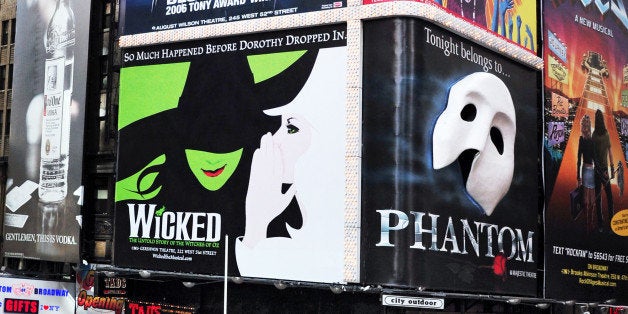
Jazz hands and... murder? It seems that the Great White Way might have a heart of darkness. With a friend coming to visit me in New York City, I was recently perusing the current Broadway listings. As I read through the list of shows and the respective plot descriptions, I started to notice a theme emerging: crime and violence. I wasn't mistaken.
Forty-three percent of Broadway productions on-stage in July 2014 have themes and content involving crime and violence. To get this number, I created a list of all Broadway productions on-stage in July, and assigned each one a value -- 0 = no violence or crime; 0.5 = shades of violence or crime, but not central to the plot; 1 = crime and/or violence as elements central to the plot; and voilà, 43 percent. While I know crime and violence are a big part of the American entertainment zeitgeist, this number surprised me. For some unknown reason, I have held a quaint and somewhat sanitized view of Broadway, despite having seen many productions myself. The reality of my experience and the notions stored in my imagination did not align.
For me, Broadway evoked ubiquitous musical numbers and tap dance windmills despite firsthand evidence to the contrary. The artistry of Broadway in my mind's eye was immune to the baser human instincts expressed via crime and violence, despite the fact that the very same can and does inspire great art. But sitting down and looking at the current productions, one by one, I couldn't sustain the Broadway of my mind much longer. In some productions, it's central to the narrative, and even in the title like, A Gentleman's Guide to Love and Murder, in others it is merely a device to drive the story along, as with The Book of Mormon. And, it comes in all shapes and sizes.
Comedy? Musical? Family entertainment? Drama? Check!
Murder? Kidnapping? Prostitution? Jail? Gangsters? Robbery? Check!
Implied? Explicit? Check!
I think this is what surprised me most. The expression of crime and violence on Broadway cuts across genre, gender, intended audience, and types of crime, though murder is by far the most popular, accounting for 69 percent of the violent content. Even The Lion King, billed as family entertainment, is predicated on an act of violence and contains themes of retribution and revenge. I guess spectacular artistry and humans playing anthropomorphized animals manage to cushion (distract from?) its essential core of violence. In turn, this prevalence also conjures thoughts about victimization, vengeance, vindication, and anticipated audience reactions. To me, these elements populate the negative space of the viewer experience and can provide as much food for thought as the intentional narrative. (Recently, actress Leighton Meester elegantly touched on some of these topics in a blog post about her experience acting in Of Mice and Men on Broadway.)
With art imitating life and life imitating art, it's no wonder that crime and violence are so prevalent on Broadway. Source material is both fiction and non-, old and new, and ultimately strives to tap into relatable parts of humanity, both the dark and the light. Translating these strains of humanity for the stage is where it gets interesting, for example, in The Phantom of the Opera obsession, stalking, kidnapping and murder are romantic fodder, in Wicked, murder is magical, and in Chicago, murder is downright sexy. On Broadway, creative license extends to the criminal.
Now, don't get me wrong, I'm not denigrating the use of violence and crime as a narrative tool. I'm a fan as much as the next person, if not more so; it gives me something to write about, right? But, in chronicling crime in our culture (in both senses of the word), I think it's important to be aware of how our exposure to crime and violence is packaged, even -- and I suppose, especially -- in the context of entertainment. Where are we getting our crime calories? The news, the Internet, social media, television, books, movies, and... Broadway.
